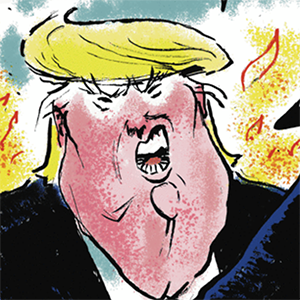Pittsburgh has seen more political TV ads than anywhere else
Published in Political News
Pittsburgh viewers tuning into "Monday Night Football" this week watched their Steelers beat the New York Giants — and 26 political ads.
That’s just a small slice of the roughly 2,300 political ads the typical Pittsburgh household has seen on television this year, according to AdImpact, more than any other market in the country.
The nonstop political onslaught for viewers, however, means a windfall for the stations. The local ABC affiliate broadcasting Monday’s game charged as much $150,000 for a single 30-second ad, an astronomical sum for the market.
Pittsburgh is the most extreme example of a phenomenon happening in swing states across the country: Campaigns and their allies are buying so many political ads that local businesses — the personal injury lawyers, car dealers and furniture stores that are usually staples of local news commercial breaks — often can’t reserve any airtime even if they could afford the inflated rates.
Advertising agencies call it “Admageddon.”
For viewers, local advertisers and even down-ballot candidates who can’t afford the premium rates that national campaigns will pay, the deluge of ads is an oppressive and sometimes unbearable force hanging over the city like the haze from its bygone steel foundries.
“The advertising is out of control. Most of them are psycho, super negative, ridiculous ads,” said Elizabeth Renshaw, 69, from the Pittsburgh suburb of Forest Hills last week. “It makes watching TV difficult.”
“I can’t remember the last time I saw a nonpolitical ad on television. It’s amazing. It’s wall-to-wall — especially during the newscasts, but anymore it’s just any time you’re watching television,” said Mike Mikus, 53, of South Fayette Township.
Keystone State
Mikus is no innocent bystander to the assault of political ads. He’s a Democratic political consultant who also produces them. He quipped that his friends blame him for the onslaught.
But even Mikus is a victim of the airwave invasion. He’s working on down-ballot races like the one for state auditor general. His client Democrat Malcolm Kenyatta has a budget of about $500,000 statewide, a tiny fraction of the $20 million that presidential super political action committees are spending in Pittsburgh alone.
Not only is Pennsylvania the most sought after state by both Donald Trump and Kamala Harris in the battle for the White House, but it has a hotly contested Senate race with Dave McCormick, the former chief executive officer of hedge fund Bridgewater Associates, challenging Democratic incumbent Bob Casey.
After Pittsburgh, the second-biggest market for political ads this year is Wilkes Barre-Scranton, Pennsylvania. Philadelphia is fifth.
Pittsburgh is unique. Its residents watch more television than any other major media market, according to a 2023 Nielsen Insights report — an average of six hours a day. And unlike the Philadelphia market, which reaches into New Jersey and Delaware, Pittsburgh ad spending isn’t wasted on large numbers of viewers who can’t vote in Pennsylvania elections.
Pittsburgh issues are driving the policy agenda in the presidential campaign. Under pressure from unionized steelworkers, both Trump and Harris have promised to block the sale of U.S. Steel to the Nippon Steel Corp. of Japan. And the region is home to rich natural gas deposits, prompting Harris to tell Pittsburgh’s KDKA-TV that she would not ban fracking as president — a reversal of her position during her 2019 campaign.
Perhaps most importantly, western Pennsylvania is at the center of the Trump-era realignment that has brought White, working-class voters who used to vote Democratic into the Republican fold. President Joe Biden worked to bring back those voters in 2020, and Harris is targeting that group with ads specifically crafted to Pittsburgh.
One Harris ad, which debuted on the Steelers-Giants Monday Night Football game, explicitly appeals to “Yinzers” — the nickname Pittsburghers have adopted for themselves after their tendency to use the word “yinz” to mean “you all.”
“I define it as somebody that bleeds black and gold, works hard and cares about their family and their hometown,” says Chris, a self-described proud Yinzer maintenance worker, in the ad. “This is our kind of town. She’s our kind of president.”
‘Political displacement’
What media buyers call “Admageddon,” the television stations call “political displacement” or “crowd-out.”
And they, too, acknowledge it’s becoming a bigger problem. Gray Television Inc. reduced its guidance on nonpolitical advertising this year by $75 million, telling investors the company was running out of room to put those ads.
For those local advertisers getting displaced — and the ad agencies that work with them — political seasons are a double-edged sword.
“It validates. People with a lot of money to spend believe that spending on broadcast television influences decision-making. So that’s good,” said Eric Perelman, president of the Pittsburgh-based Nartak Media Group.
“On the bad side, on the reality side, broadcast TV has a finite amount of inventory,” he said. “No local advertisers can compete with politicians when it comes to budgets and spending.”
The Pittsburgh Public Theater typically advertises productions on morning TV shows. But a 30-second spot that used to cost $400 is now at least $1,500, said the theater’s marketing director, Aja Jones.
It’s not just TV, she said. Mailers for their production of "The Hobbit" — running through Nov. 10 — are getting buried under a deluge of political mail, if they even get delivered on time. Jones said her direct mail pieces have been delayed by weeks. As a result, ticket sales are slower than usual.
Americans have long had a love-hate relationship with advertising — and particularly television ads.
“They interrupt what people want to be doing,” said Kathy M. Newman, a film professor at Pittsburgh’s Carnegie Mellon University who has studied the intersection of advertising and politics throughout history. “Advertisers know we don’t like it, and they do it anyway.”
But campaigns keep advertising, in part because it works — and could tip the election in an extremely close race.
“There are absolutely diminishing returns,” said Mark Harris, a Republican strategist from Pittsburgh who’s working on McCormick’s Senate campaign. “But even in a diminishing-returns environment, TV remains a pretty good medium — particularly to reach the sort of low-information voters who are so important in this election.”
©2024 Bloomberg L.P. Visit bloomberg.com. Distributed by Tribune Content Agency, LLC.




























































Comments